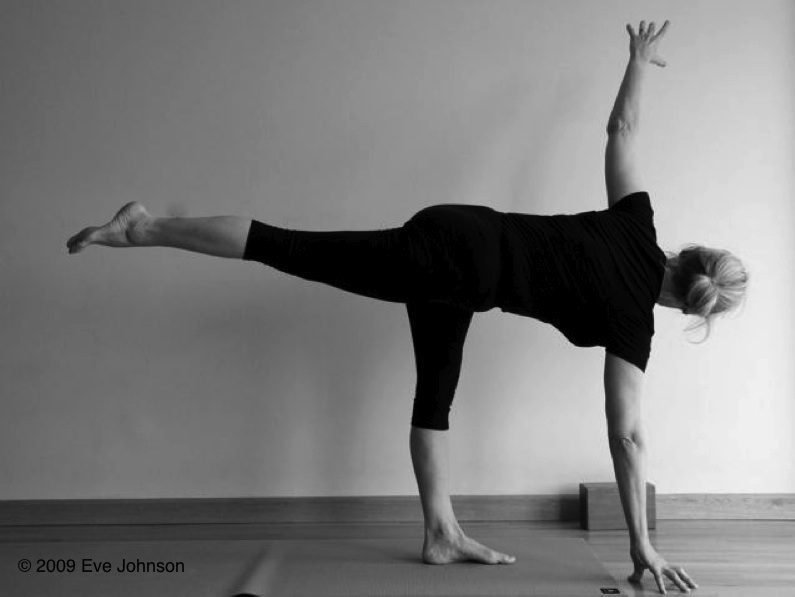Tight hips have a lot to answer for, and it isn’t just that they keep you from sitting cross-legged in comfort.
Tight outer hips in particular lead us to stand with our toes rotated outward, putting strain on our knees and lower back. In our intricately connected bodies, they can even contribute to shoulder pain.

Parivritta Ardha Chandrasana – Rotated Half-Moon Pose
Parivrtta Ardha Chandrasana (rotated half moon pose) is a magnificent way to stretch your outer hips.
As his daughter Geeta tells it, it was invented when B.K.S. Iyengar was searching for release for a “catch” in his back. One day, in the deep twist of rotated triangle, he had a sudden intuition. He lifted his back leg and into rotated half moon, and in that moment felt the release.
But here’s a catch of a different kind: if your outer hips are tight, then rotated half moon can be startling in its intensity, not to say painful.
Here’s one way to create more open, flexible outer hips as you prepare for the full pose.
Lie down on the floor with your left side parallel to the wall. Stretch your left arm out to the side. If you can touch the wall with your fingertips, you’re at about the right distance.
Now bend your right knee. Insert your right thumb into your right hip crease and pull down toward your buttock. Keeping the right side of your ribcage long, bring your right foot to the wall. Check that your right shoulder rests easily on the floor.

As you inhale, expand your chest. As you exhale, relax your belly and press your right ribcage toward the floor.
Feel the stretch in your outer right hip. As you inhale, move your breath into your hip, bringing warmth and expansion into the muscles. As you exhale, release tension from your right hip.
When you are well settled into position, close your eyes and visualize your back resting on a wall, and your right foot pressed into the floor. Extend through the ball of your left big toe. With each exhalation, feel your spine rotate towards the “ceiling.”
Hip work takes patience. Spend at least two to three minutes on each side. If you can squeeze a little more time out of your day, five minutes per side is even better.
Benefits: This preparation will open your hips, stretch your legs, improve your breathing by opening your chest, stimulate your abdominal organs and relieve mild back pain. It will also give you that peaceful feeling that comes from hip openings.
If you spend time in the pose visualizing your back against the wall and your foot on the floor, you will create a pattern of the full pose in your mind. When you do try the full pose, your body will already know how it should feel, and have a sense of what’s required to make that happen.
Sequence: Do this position on its own any time your body craves a deep twist. Try it before a standing pose practice that includes deep standing twists, including Parivrtta Trikonasana (rotated triangle), Parivritta Parsvakonasana (rotated side angle pose) and rotated half moon, or seated twists and Padmasana (lotus pose).
Ouch: If your hips are tight, you may have trouble getting your foot to rest on the wall. Move a few inches closer to the wall and try again.
If your hamstrings are tight, you may have trouble feeling the stretch in your hips. Bend the knee of the leg that’s at the wall and move it higher, so it rests in line with your hip joint.
Avoid this exercise if you have a severe back problem, a headache, or diarrhea.
Sansrkit corner: Say par-ee-VRIT-tah are-dah chan-DRAH-sanna. Parivrtta means rotated or revolved. Ardha means half. Chandra means moon. Asana means pose.
Photo credit: Black and white photo by Pandora Yeung.




Comments on this entry are closed.
As another Iyengar practitioner obsessed with feet and toes… Which way do you recommend turning your grounding leg (ie, the left leg in your example)?
Do you let it turn toward the wall (the way it would face in parivrtta ardha chandrasana)? Or do you resist the keep it pointing up (perhaps to work the left inner thigh as a bonus)?
Will try this tomorrow!
YogaSpy
http://yogaspy.com
Good question Yoga Spy!
My first instinct was to say that I don’t notice the foot, I just bliss out in the hip opening. But then I tried it again with your question in mind and found that in fact, what feels natural to me is to keep the foot upright and roll the inner left thigh in. I suspect it feels natural, in part, because it deepens the stretch in my hip.